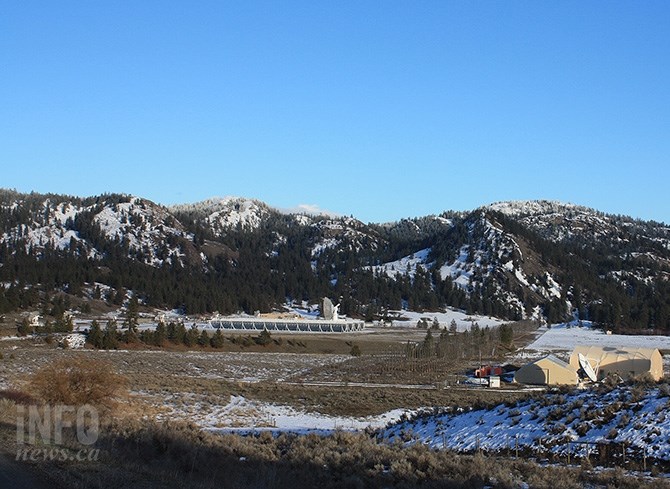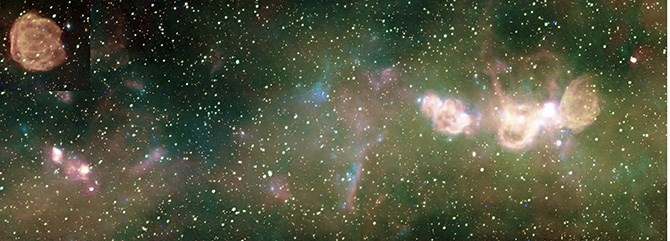
A Synthesis Telescope at the Dominion Radio Astrophysical Observatory.
Image Credit: Mark Klotz via Flickr
February 20, 2016 - 12:00 PM
PENTICTON - There’s a world class facility in a side valley of the South Okanagan that’s helping mankind unlock the secrets of the universe through its research and development.
But you could pass within a few kilometres of it on Highway 97, south of Penticton, and except for a highway sign, have no idea of its existence. Not that the Dominion Radio Astrophysical Observatory is hiding, but that's kind of the point.
In the 1950s, a cross-country search for a site for Canada’s largest radio telescope found the White Lake Basin, 22 kilometres southwest of Penticton. It was seen then, as now, as the best place in Canada for radio astronomy. It's close enough to civilization, yet the site was so completely ringed by mountains that even today the observatory faces few extraneous radio frequency signals.
“We can’t detect radio frequency emissions from Okanagan Falls, five kilometres away,” obersvatory director Sean Dougherty says, adding a small subdivision just down the road at St. Andrews is the only piece of civilization the observatory can 'see.'
The observatory’s location close to Penticton also means the institution is able to maintain a long-term body of on-site engineers, scientists and technologists.
The Regional District of Okanagan Similkameen has written protection for the observatory’s need for radio signal shielding into its long-term growth strategies. Dougherty says the regional district has been very cooperative in ensuring the science continues in the White Lake basin.
“Living near a valley that contains a quarter of a million people, we do pretty well,” Dougherty says.

The Dominion Radio Astrophysical Observatory on White Lake Road, southwest of Penticton. The site was selected in the late 1950s because of its unique ability to shield the observatory from man made radio frequencies.
(STEVE ARSTAD / iNFOnews.ca)
The sight of the observatory’s telescopes do not bring to mind images of the telescopes common to most of us. Think sound, not sight. The telescopes at White Lake are designed to receive naturally occurring radio waves from the universe rather than light, so they look more like deep-space tracking antennas.
The universe they reveal is dramatically different from what is observed in conventional, optical telescopes, observatory astronomer Ken Tapping says.
The observatory is currently developing a new telescope at the White Lake site. Known as CHIME, when in operation it will be Canada’s largest radio telescope. The observatory is also involved in an international project to build what is known as the Square Kilometre Array.
Probably the most widely used astronomical data coming out of White Lake Observatory is that which is gleaned from it’s solar flux monitor. Two dishes make up the unit, which monitors the sun for such activity as solar flares and sunspot activity.
“The data from the solar flux monitor is the most widely used astronomical information in the world,” Dougherty says. “There are countless uses for it, in particular by power utilities and satellite systems. They need the information to be able to protect their sensitive electronic hardware from solar storms.”
Globally, the observatory is best known for being on the leading edge of digital processing technology.
The observatory is also working on new technologies. Composite radio telescope development which uses carbon reinforced plastic could be a game changing technology for the satellite communications industry. A Saskatchewan company spent much of the past year working with the observatory to develop the technology for their use, Dougherty says.
Forty employees work on the site, with additional research associates and student positions which come and go.
“We have a great staff. They are the best in the world at what they do,” Dougherty says.
The observatory is preparing to celebrate the National Research Council’s Centennial this year, with an open house scheduled for a date to be announced in May.

This is a radio image made during the Canadian Galactic Plane Survey. The primary instrument in the project was the DRAO Synthesis Radio Telescope.
In the top left corner is a "supernova remnant"; the remains of an exploded star. The debris ejected in the explosion is colliding with the surrounding gas and dust clouds, creating a bubble. On the right is a complicated star formation region. There is a big cloud of gas and dust extending across the area in the image. Stars are forming in those clouds on the right, which are making their birth clouds hot. There is another such region but much smaller in the lower left.
The starlike points are not stars. The Sun is the only normal star close enough to us for its radio waves to be detectable. All those dots are radio images of very distant galaxies.
This image shows the sky as it would appear to us if we could see radio waves. The supernova remnant in the upper left would appear about the size of the full moon in the sky.
Image Credit: Dominion Radio Astrophysical Observatory
To contact a reporter for this story, email Steve Arstad at sarstad@infonews.ca or call 250-488-3065. To contact the editor, email mjones@infonews.ca or call 250-718-2724.
News from © iNFOnews, 2016